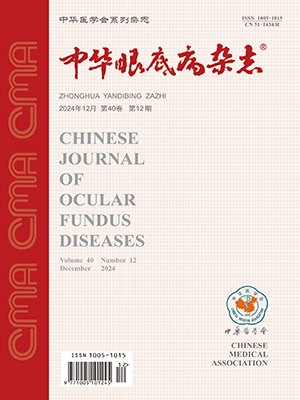| 1. |
Querques G, Kuhn D, Massamba N, et al. Perifoveal exudative vascular anomalous complex[J]. J Fr Ophtalmol, 2011, 34(8): 559. DOI: 10.1016/j.jfo.2011.03.002.
|
| 2. |
魏文文, 于伟泓, 李略. 黄斑中心凹旁渗出性血管异常复合体一例[J]. 中华眼科杂志, 2019, 55(6): 458-459. DOI: 10.3760/cma.j.issn.0412-4081.2019.06.010.Wei WW, Yu WH, Li L. Parafoveal exudative vascular complex: a case report[J]. Chin J Ophthalmol, 2019, 55(6): 458-459. DOI: 10.3760/cma.j.issn.0412-4081.2019.06.010.
|
| 3. |
Zhang Z, Xu L, Wu Z, et al. Case report: perifoveal exudative vascular anomalous complex in a Chinese patient with diabetes mellitus[J]. Optom Vis Sci, 2019, 96(7): 531-535. DOI: 10.1097/OPX.0000000000001401.
|
| 4. |
Sacconi R, Freund KB, Yannuzzi LA, et al. The expanded spectrum of perifoveal exudative vascular anomalous complex[J]. Am J Ophthalmol, 2017, 184: 137-146. DOI: 10.1016/j.ajo.2017.10.009.
|
| 5. |
Mrejen S, Le HM, Nghiem-Buffet S, et al. Insights into perifoveal exudative vascular anomalous complex[J]. Retina, 2020, 40(1): 80-86. DOI: 10.1097/IAE.0000000000002435.
|
| 6. |
Kim JH, Kim JW, Kim CG, et al. Characteristics of perifoveal exudative vascular anomalous complex in Korean patients[J]. Semin Ophthalmol, 2019, 34(5): 353-358. DOI: 10.1080/08820538.2019.1626450.
|
| 7. |
Verhoekx JSN, Smid LM, Vermeer KA, et al. Anatomical changes on sequential multimodal imaging in perifoveal exudative vascular anomalous complex[J]. Retina, 2021, 41(1): 162-169. DOI: 10.1097/IAE.0000000000002809.
|
| 8. |
Henriques J, Pinto F, Rosa PC, et al. Continuous wave milipulse yellow laser treatment for perifoveal exudative vascular anomalous complex-like lesion: a case report[J]. Eur J Ophthalmol, 2022, 32(1): 119-124. DOI: 10.1177/1120672120966564.
|
| 9. |
Sacconi R, Borrelli E, Sadda S, et al. Nonexudative perifoveal vascular anomalous complex: the subclinical stage of perifoveal exudative vascular anomalous complex?[J]. Am J Ophthalmol, 2020, 218: 59-67. DOI: 10.1016/j.ajo.2020.04.025.
|
| 10. |
Smid LM, Verhoekx JSN, Martinez Ciriano JP, et al. Multimodal imaging comparison of perifoveal exudative vascular anomalous complex and resembling lesions[J]. Acta Ophthalmol, 2021, 99(5): 553-558. DOI: 10.1111/aos.14650.
|
| 11. |
Fernández-Vigo JI, Burgos-Blasco B, Dolz-Marco R, et al. Atypical perifoveal exudative vascular anomalous complex (PEVAC) with multifocal and bilateral presentation[J/OL]. Am J Ophthalmol Case Rep, 2020, 18: 100717[2020-04-21]. https://pubmed.ncbi.nlm.nih.gov/32368691/. DOI: 10.1016/j.ajoc.2020.100717.
|
| 12. |
Bourhis A, Girmens JF, Boni S, et al. Imaging of macroaneurysms occurring during retinal vein occlusion and diabetic retinopathy by indocyanine green angiography and high resolution optical coherence tomography[J]. Graefe's Arch Clin Exp Ophthalmol, 2010, 248(2): 161-166. DOI: 10.1007/s00417-009-1175-6.
|
| 13. |
Sacconi R, Sarraf D, Garrity S, et al. Nascent type 3 neovascularization in age-related macular degeneration[J]. Ophthalmol Retina, 2018, 2(11): 1097-1106. DOI: 10.1016/j.oret.2018.04.016.
|
| 14. |
Takayama K, Ooto S, Tamura H, et al. Retinal structural alterations and macular sensitivity in idiopathic macular telangiectasia type 1[J]. Retina, 2012, 32(9): 1973-1980. DOI: 10.1097/IAE.0b013e318251a38b.
|




